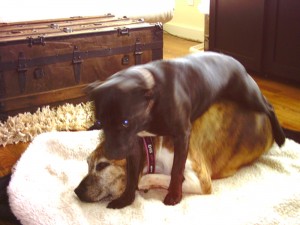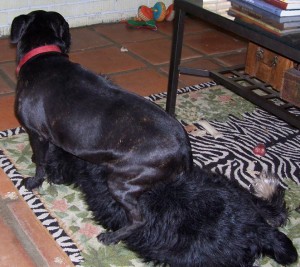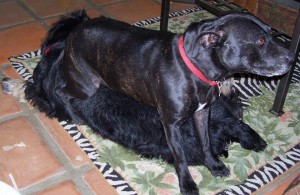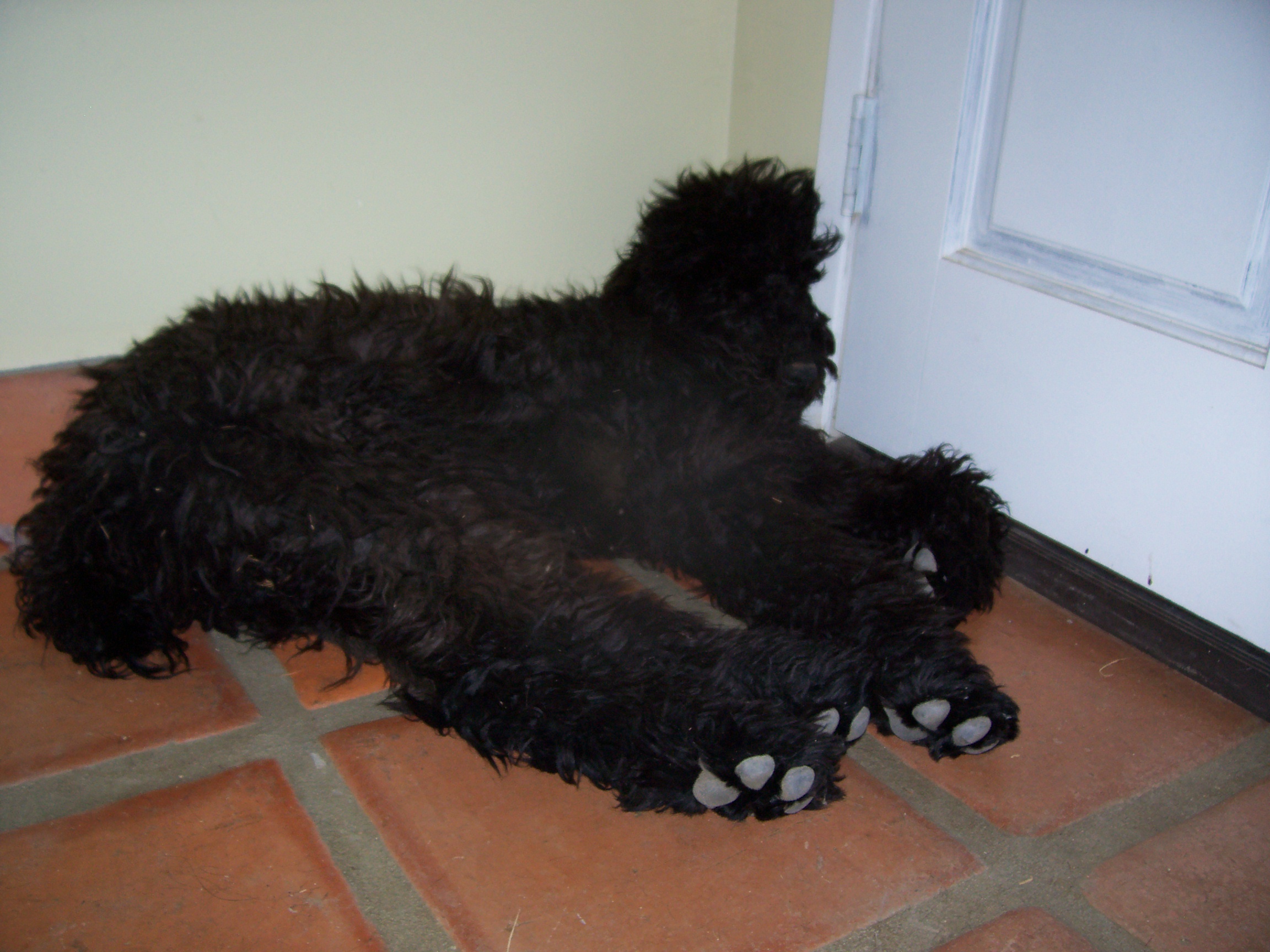Posted on Oct 04, 2009
Behavioral Modification, Dog Psychology, Dogs and Instinct, Pit Bull, Timid Dog Behavior
Dogs are similar to us when it comes to needing to feel secure. They may have a past of abuse or may be genetically hard wired to be timid or insecure. Everyone knows and appreciates what it means to hear someone say, “I’ve got your back.” That someone accepts you for who you are; even, or especially when you feel insecure. Olive, a very special Staffordshire Bull Terrier (with an abusive past), was openly insecure and needed someone to have her back in more ways than one.
In her case, it was more that she needed to have someone’s back – literally, to be able to relax and trust what was going on around her. If you don’t think dogs need a connection to feel secure, think again.
In this photo, Olive was finding comfort on her life-long companion, Chapin, who always allowed Olive to find her “calm” while resting on top of Chapin.

After Chapin passed, the next two photos show how Olive tried to find that same security in Zoe. It appears that Olive knew something very valuable – they had her back while she had theirs.


Posted on Oct 01, 2009
Behavioral Modification, Discussion Tab, Dog Psychology, Dog Training, Dogs and Instinct
As a constant observer of dogs, I am still amazed at how shifts in their behavior occur as they mature. It is interesting to see how at times they will appear to be practicing to be dominant. I’ll explain using two separate incidences.
I was working with a dog who is a big fan of chasing anything that moves or may move or used to move! On this occasion, we were making progress with him when I looked down to notice his hackles were up. I couldn’t help but think the timing was off. Something in him triggered this response and he even seemed unsure about his behavior. Natural, though it is, I believe he was in a sense trying out his maturing instincts. The dog didn’t appear to feel threatened. It was either a delayed or premature response. Practice perhaps?
Recently, my own dog who is 18 months of age, kicked up his back legs for the very first time. It was a macho move, but he was awkward and the action appeared misplaced. He looked up at me as if to say, “look, I’m kicking my legs up!” It was like he was practicing for when he would need to show his new-found dominant move. My other thought was that he had witnessed this strut as done by his little (tiny in comparison) brother, who exhibited this macho-manner after nearly every potty break.
I believe they are trying on things much like when you are fortunate enough to see a child as they catch their reflection in a mirror practicing a confident look or pose. It’s not a necessary posture at that moment, but it may be and one needs to be prepared!
As you enjoy the many changes that occur in the life of your dog, watch carefully for those times when they appear to be growing into their instincts.
If your maturing dog is exhibiting new behaviors and you aren’t sure how to handle them, please submit your question in the box to the right (I share it with Melody).
Posted on Sep 28, 2009
Aggression, Behavioral Modification, Dog Food, Dog Psychology
I have heard from numerous clients that their dog is a picky eater. They either say that or, “he doesn’t eat very much.” Typically, I suggest moistening the food with a little water and perhaps adding a few snippets of something a little more tasty than their kibble. This works for some dogs. There’s something about a little gravy that turns meal time into a treat!
I have had several of these “picky” eaters boarding with me, and guess what? When they were around other dogs eating, they paid more attention to their food bowl and making sure the other dogs did not move in on their what-used-to-appear-bland kibble.
It may not be feasible for you to have your dog eat with another dog, but I can almost guarantee, they would have a new appreciation for the food that is set before them! I don’t suggest feeding dogs out of the same bowl, but this was a photo opportunity I couldn’t pass up…

By the way – notice that two of the dogs are Pit Bulls. Somone forgot to tell them to be aggressive!
Posted on Sep 22, 2009
Behavioral Modification, Dog Chases Car, Dog Psychology, Dog Training, Palm Springs Dog Training
If your dog is one of those that loves to focus and obsess on moving objects, i.e., cars, golf carts, or even vapor trails from airplanes, this post is for you.
This activity may now be a pattern of behavior that is rapidly becoming a habit. See car – chase car. Sound familiar? You hear the engine in the distance (just after the dog) and brace yourself with the you-won’t-pull-me-down-this-time stance as you feel embarrassed and aggravated that your dog is officially a car chaser.
- First, you want to master (and be the master) of having your dog heel. This means your dog is walking on a loose leash next to your side.
- Work with them to sit when you stop and on command even when they are distracted. Add stay and increase their ability to stay by throwing treats in front of them, walking all the way around them, and using other staged distractions.
- Now, take your dog to the street and have someone in a car work with you to desensitize the dog to the moving vehicle. Have the car drive by slowly and stop in front of you allowing you time to have your dog sit. Repeat this process eventually working with your dog in a down and stay. This is a more submissive and relaxed position and they can’t lunge when lying down.
- The second you sense they are beginning to focus on the car or even just the sound of it approaching, say their name in a positive tone. You want them to shift their focus to you. You will be wasting your voice and energy if they have already bolted, you’ve lost control, and you are yelling their name followed by sit. Take a breath, get yourself focused and feeling confident, and continue the training.
If this behavior has been tolerated for awhile, it may take awhile to break their pattern of response. Some breeds are more prone to chase moving things, so you are also working against or with that instinct. Take it slow. Too much, too fast, and your dog may get over-stimulated.
It’s also important to consider that if your dog has been confined all day and has energy to burn, provide exercise prior to training so all of that energy isn’t going toward the behavior you want to correct – in this case, car chasing.
Please contact me in the box to the right if you have any questions! (I share this box with Melody)
Posted on Sep 15, 2009
Barking, Behavioral Modification, Dog Humor, Dog Training
I know you’ve heard it more than once from me that dogs bark. That’s their voice. How much they have to say and when they say it, may need to be fine-tuned!
As a personal note, my little guy, Moby (please never tell him he is little), feels the need to exit the slider as he announces to any and all who might go before, after, or are outside when he approaches that he is coming and he is to be feared.
As the temperatures cool and dogs (in the desert) are out more, they may become more excited (accompanied by vocal expression – i.e., barking) in exclamation that they can once again be given free access to the outside world that fears and respects them.
Tonight, Moby was declaring his presence to a neighboring dog. I walked outside and sometimes that alone is enough. This time, I gave the human hand signal for “cut” by turning my flattened hand toward my neck as I said “ixnay arkingbay.” He stopped immediately and hasn’t barked since.
Why do I share this moment of enlightment? To let you know that once your dog listens, respects, and responds to you, you can even speak in pig Latin and they will get it. It all means stop, and most important is the energy behind your words. Their respect for you will be evident.
Posted on Sep 12, 2009
Behavioral Modification, Discussion Tab, Dog Psychology
There’s an interesting study about dog behavior being conducted at Harvard. A few of the observations:
* Is your dog patient? If given a choice between 1 treat immediately, or 5 treats in a few minutes, will your dog wait patiently for the 5 treats?
* Can your dog cooperate with a human or another dog to gain access to a highly valued reward, and if this capacity is in place, does your dog recognize that some efforts to cooperate merit greater rewards than others?
* Does your dog distinguish between accidental and intentional actions?
Here’s the link and a short video worth watching. Harvard Canine Cognition Lab
Some of you may not want to know how smart your dog really is! I’m waiting for them to clean up after themselves and perhaps do a little dusting.
Posted on Sep 03, 2009
Behavioral Modification, Dog Psychology, Dog Training
Gaining the respect of someone is much the same as it is with a dog. It’s not about how strong or big or how loud you can yell. It’s about being in a calm state of mind that is confident, in control, and worthy of the respect you expect.
Melody, a 5 lb yorkie, came into the house and gained the respect of the other dogs. Let’s face it, she’s a toothless, de-barked little thing who manages to handle the big dogs just fine. She is afraid of a human’s intention, but a 120-lb Dane will easily move away from it’s bowl of food if Melody approaches. They all clear a path for her as she dodges big feet and long legs to get to her bed.
If she had words, she would be a good example for a woman’s self-defense course on how to assert yourself with little effort. She is who she is and they know she knows it! I wonder what she does know? It’s definitely the calm, assertive nature Cesar Millan speaks of so often.
Humans usually require training tools in working their dogs, and there’s nothing wrong with that. That’s what they are – tools. Be it a collar and a leash or a remote training device, it will be far more effective when we are worthy of the dog’s respect without these tools. When the collar comes off, the dog should still listen and respond and basically look to you for approval because they know who is in charge.
Their tail won’t be tucked in fear, their ears won’t be back and heads down because they are afraid of the hand approaching them. They will be happy, confident, and balanced dogs whose respect of you is natural.
Posted on Sep 03, 2009
Adopt a Shelter Dog, Doggie Rehab, Puppy Mills
Best Friends Animal Society’s “Pup My Ride” Program is back in the Midwest, transporting more than 150 rescued Puppy Mill Dogs to rescue groups in New York and New Jersey. Thank you Best Friends!
A video featuring Beatrice and Beauty













